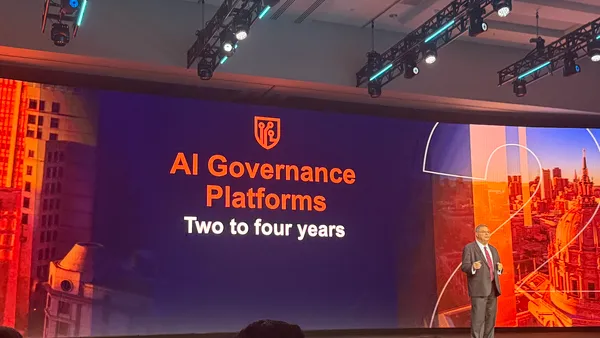As SurveyMonkey works to secure its place in the enterprise software market, the company's first CIO, Eric Johnson, wants to execute on a two-year playbook that features automation, efficiency and data analytics.
But before any of that can take place, Johnson must make his case internally.
In the two months he's served as CIO, Johnson — a 20-plus-year tech exec with past stints at Talend and DocuSign — has focused on surveying the existing capabilities of the infrastructure and finding areas of improvement.
He's also been working to communicate the role and scope of a CIO, and what it would look like at the survey software-maker.
"I've spent a lot of time inside different areas, giving presentations and talking to leadership teams," Johnson told CIO Dive. In the meetings, he's described his charter of action and explained what kind of value he wanted to deliver for the company.
Founded in 1999, the company brought in $254.3 million in revenue in 2018. The addition of a CIO came 10 months after going public. The strategy — aimed at scaling security, data infrastructure and business intelligence capabilities — now hinges on Johnson's ability to get internal buy-in and executing on the long-term play.
Making a strong pitch to the company is a necessary step for incoming CIOs, according to management consultant Alan Kraus, founder of Blind Spot Strategy.
"The CIO should help to get everyone on board" with the message that a CIO addition signifies growth within the organization, said Kraus.
In Johnson's initial conversations, staffers were "nothing but incredibly welcoming and supporting" as he laid out how the CIO role would come into play in areas like compliance, risk and security.
But he admits adjusting to change "takes people a little bit of time," as the organization moves the focus away from granular tech decision-making, and into companywide strategies.
What's pressing?
SurveyMonkey's play for the enterprise space is all about collecting company data to help managers glean insights into their businesses. In that context, security has to be key.
But the IT infrastructure, Johnson said, will need attention in order to scale as fast as the company.
"You start to run into scale, compliance and security issues you need to be prepared for," said Johnson.
In meetings with leadership and direct staff, Johnson laid out four buckets of priorities for the coming 18-24 months:
- Automation: Using data integration tools, SurveyMonkey wants to move data more efficiently between apps. RPA providers will come into the fold to support business processes.
- Security and compliance: In this space, Johnson also plans to get support from automation.
- Data analytics: Over the next 18 months, the company expects to modernize its data infrastructure.
- Internal tool use: SurveyMonkey wants to "be a reference" at using its technology to get insights on its business and operations.
How to be heard
Johnson, like any incoming CIO, is tasked with helping the organizations sustain its innovation and competitive relevance.
Through data analytics and business insights, CIOs often equip leadership with more complete overviews of the inner workings of a company.
Though in theory the addition of a CIO can bring companywide benefits, that shift can also come with resistance, according to Kraus.
"Some of that is about culture and some is about helping people understand how they can now use this new information," Kraus said.
Johnson plans to leverage his business experience to get buy-in, not just downstream, but upstream in the organizational chart.
"If you have a seat at the table, which I do, ... you need to be positioning things in business context," Johnson said. "People will see you as a technologist first and a business person second. My job is to make sure I'm putting things in business context so that it resonates with the executive team."














